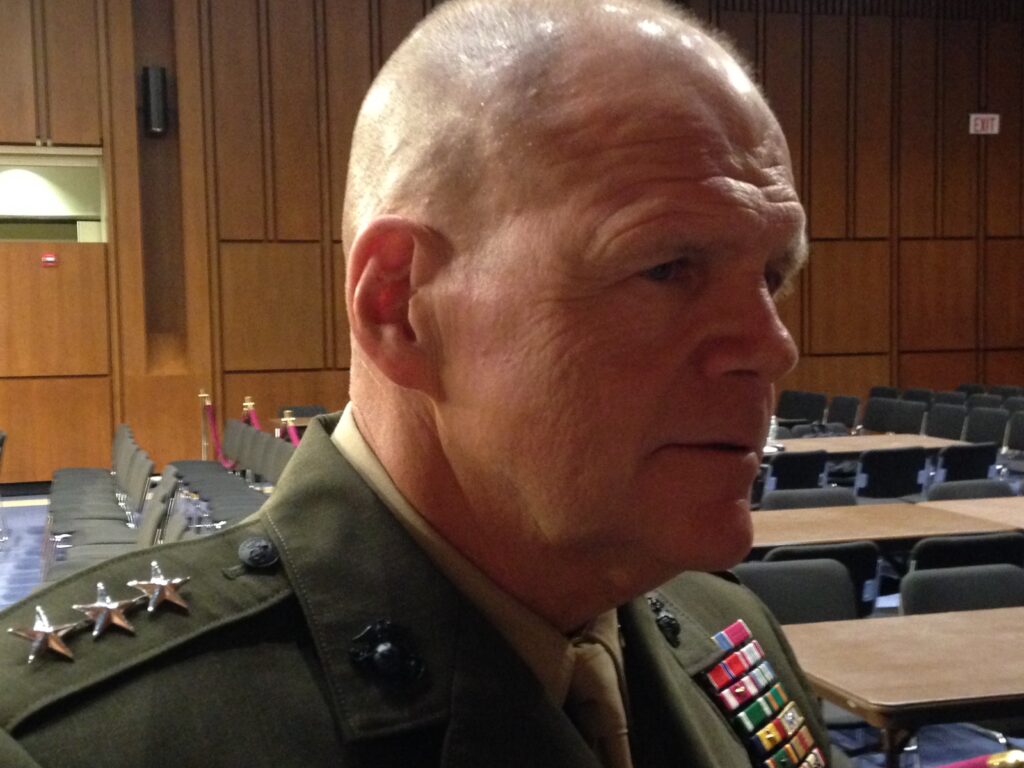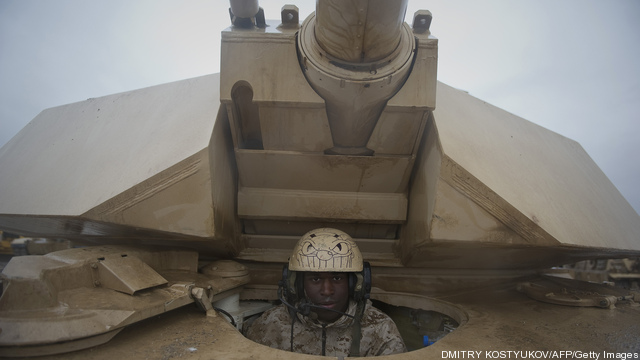Mini-Drones & Bayonets: New Marine Warfare Concept
Posted on

Gen. Robert Neller
After a generation spent fighting guerrillas, the Marines have just rolled out a new concept for high-tech combat against a nation-state — a concept they’re developing in unusually close concert with the Army and Navy.
“There’s a lot of Navy in it,” said Marine Corps Commandant Robert Neller, introducing the new Marine Corps Operating Concept (MOC) this morning during the Modern Day Marine conference in Quantico. As a companion piece, he went on, “we have written a combined Army-Marine document about…land warfare.” That refers to a draft white paper, jointly commissioned by Neller and Army Chief of Staff Mark Milley, on what the Army’s calling Multi-Domain Battle. (Neller will discuss the topic at next week’s Association of the US Army conference).

Gen. Mark Milley
Past efforts to coordinate with the Army on, say, buying equipment were “a little disappointing,” Neller said, promising to push for more closeness. “There’s always been tension between the armed services because of resources, but I want a big, strong Army and a big, strong Air Force and a powerful Navy.”
All four services are wrestling with the same problem: so-called Anti-Access/Area Denial systems (A2/AD). These are complex and high-tech networks of sensors and missiles that China, Russia, and other powers like Iran are developing to keep American ships and planes at bay. Starting around 2011 with the influential Air Force and Navy concept called Air-Sea Battle, a consensus has started to emerge among the services: Defeating A2/AD requires every service using every avenue of attack, from long-range missiles and computer viruses to mini-drones and brutal close combat.
Marines must wage “four-block war (in) six domains,” Neller said this morning. That’s a reference to legendary Commandant Chuck Krulak’s “three-block war” in which humanitarian relief, peacekeeping, and open violence occur simultaneously just streets apart, with the 21st century addition of information operations — everything from radio jamming to social media — as the fourth, virtual block. The six domains are the five officially recognized by Pentagon doctrine — land, sea, air, space, and cyberspace — with the addition of the electromagnetic spectrum, which is essential to everything from radar to wifi.
The Marines have long fought with equal facility on land, on the sea, and in the air. The new concept calls for them to extend their influence, if not their physical presence, into space, cyberspace, and the spectrum as well.
Marines use off-the-shelf Samsung tablets to coordinate operations from the back of a V-22 Osprey in an Infantry Officer Course experiment.
Technology & Its Discontents
Part of the solution is new tech — though it doesn’t have to be expensive. “My goal is, at the end of next year, every deployed Marine infantry squad has their own quadcopter” for aerial recon, Neller said this morning. Maybe, he added, we can even 3D print mini-drones on demand. After all, he said, “in 10 years, we’ll be 3D printing chow.”
The audience chuckled, but Neller was only slightly tongue in cheek. “They’re already printing food — and you didn’t like the chow now,” he said to further laughter. From printing food to parts to mini-drones, he said, “it’s gonna disrupt everything we know about supply — which I think is pretty cool.”
No matter how great the tech, however, war will remain war, Neller warned. As Sun Tzu said, “the ultimate is to defeat the enemy without fighting — that’s easy to say. That’s hard to do,” the commandant said. In the final analysis, he went on, alongside all the new skills, “we have to be able to break stuff.”
At some point, a future fight will come down to “they’re right there on that hill — go kill ‘em,” Neller said. “That’s what we do.”

Marine tanker
21st Century Maneuver Warfare
As all the services pivot from counterinsurgency to great power war in Europe and the Pacific, they are forced to wrestle with Anti-Access/Area Denial, Deputy Commandant Robert Walsh told me in an interview after the commandant’s speech.

Lt. Gen. Robert Walsh
“These concepts we’re working on with the Navy and with the Army tie to A2/AD,” Lt. Gen. Walsh said. In both the Army-Marine draft “Multi-Domain Warfare” and Navy-Marine draft “Littoral Operations For A Contested Environment,” he said, the objective isn’t to destroy the Anti-Access/Area Denial system completely, but rather to find and widen weak points through which to push.
We’re out of practice finding enemy weak points. In the Gulf War, Afghanistan, Iraq, Libya, and even Syria, while enemies may have impeded us on the ground, the US has grown accustomed to complete air superiority, complete freedom of maneuver, complete freedom to use cyberspace and the electromagnetic spectrum. That’s not going to happen against A2/AD, Neller and Walsh made clear.
“It’s not going be supremacy across the whole theater, it’s going to be pockets of supremacy,” Walsh told me. “We’ve got to be able to (create) this bubble where we can survive and operate, (then) maneuver that bubble around and strike and operate from it.”
It’s a 21st century application of maneuver warfare, the concept invented by German stormtroopers in 1961, made infamous by the blitzkrieg in 1940, and held as central to Marine Corps doctrine since the 1990s. Likewise, the emphasis on using all means in all domains — from infantry rifles to F-35 stealth fighters to social media — is an expansion of the classic military principle of combined arms, another sacred Marine Corps tenet. Even the idea of operations in one domain affecting another is very familiar to the Marines, who’ve deployed from ships to shore and then marched on inland since 1805.
“We find it very easy to think through this in our world,” Walsh said. “We’re very comfortable operating in this environment.”
The challenge is applying traditional Marine Corps principles in new ways with new tools, Walsh said. Technology is just a means to an end: “It allows us to operate in our normal traditional constructs of maneuver and combined arms,” he said, “in a 21st century way that we weren’t able to do before.”

CSBA graphic
The War In 2025
So how would this work in practice? The Marine Corps Operating Concept opens with a fictional vignette of an operation against an unnamed but well-armed foe in 2025. (Fiction in Marine doctrine dates back at least to the classic Command & Control in 1996). The scenario opens with Marines in a threatened friendly country doing classic low-intensity missions, training local forces, learning the cultural and political landscape, and building goodwill. But when an enemy comes across the border in force, the Marines fall back to their ships and seize a strategically located island as a forward base for incoming reinforcements.
The island operation is an evocative mixture of high and low technology. Drones and special operators map out landing sites, then Marines arrive in small boats under cover of darkness. The troops march on foot throughout the night, using map and compass because GPS is down. Then, on arriving at their objective, they pull out mini-drones and precision-guided mortar rounds.
Throughout the campaign, the Marines move in small, dispersed, but coordinated units to avoid being seen and targeted by enemy precision weapons. Supplies arrive not by lumbering truck convoys but on cargo drones. Communications come in and go out with enemy jamming, but well-trained and self-confident young officers keep going on their own initiative based on their commanders’ intent. As the operation moves into urban areas, they navigate both the physical landscape and its social media to hunt the enemy without alienating neutrals.
Critical thinking is as essential as combat skills amidst this complexity, the document says: “We need Marines with mental acuity and resilience no less than physical fitness.”
Subscribe to our newsletter
Promotions, new products and sales. Directly to your inbox.
